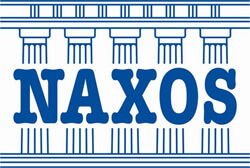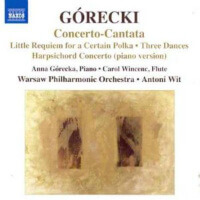 Most musicians and audience members alike know Henryk Mikolaj Górecki (1933-2010) primarily for his Symphony of Sorrowful Songs, which was composed in 1976. That work didn’t gain Gorecki’s current international attention until the 1992 release of the Nonesuch recording, performed by the London Sinfonietta with Dawn Upshaw as soloist. My experience with Gorecki’s music prior to listening to Naxos’ release of Concerto-Cantata included that recording of the Third Symphony, and also his third string quartet …Songs are Sung, written in 1995 for the Kronos Quartet and dedicated to the victims of the Holocaust.
Most musicians and audience members alike know Henryk Mikolaj Górecki (1933-2010) primarily for his Symphony of Sorrowful Songs, which was composed in 1976. That work didn’t gain Gorecki’s current international attention until the 1992 release of the Nonesuch recording, performed by the London Sinfonietta with Dawn Upshaw as soloist. My experience with Gorecki’s music prior to listening to Naxos’ release of Concerto-Cantata included that recording of the Third Symphony, and also his third string quartet …Songs are Sung, written in 1995 for the Kronos Quartet and dedicated to the victims of the Holocaust.
The Naxos release takes it’s title from the second work on the recording, Concerto-Cantata. Gorecki completed the work in 1992, and it first performed by flutist Carol Wincenc with the Netherlands Radio Philharmonic Orchestra and Eri Klas. Wincenc also performs the flute solo in this recording, this time with the Warsaw Philharmonic Orchestra (national orchestra of Poland). The title Concerto-Cantata is a reference to the titles of each of the four movements, which are similar to those used in the high baroque era. The first movement, Recitativo, begins with a single unaccompanied line (or motive, really) in the very lowest register of the flute. From this almost silent beginning, a haunting monologue emerges, and slowly grows until it is suddenly punctuated by unison brass and strings in the final thirty seconds of the movement. The second movement, Arioso, flows seamlessly from the end of the Recitativo. The second movement continues the growth of the Recitativo into the comparatively angular dance-like Allegro. The final movement, Arioso e Corale, brings the piece full circle, returning to the introspective flute monologue of the beginning.
My favorite work on the CD is the Three Dances, a suite of dance movements showing a wide variety of character. The first movement, Presto, begins with a guttural ostinato pattern in the strings punctuated by changing accents almost reminiscent of the Rite of Spring. The second movement (Andante Cantabile, Tranquillo) contrasts so strongly with the first I at first thought that the CD had stuck and stopped playing. It reminds me of Gorecki’s heart-wrenching third string quartet …Songs are Sung. Even the harmonic progressions are in a similar style, with repeating patters that grow in intensity until fading back into tense near-silence only to grow into huge swells of emotion once again. The third movement returns to the Stravinsky-like qualities of the first, with a full orchestration and a proliferation of folk-like rhythms. The end is hammered home almost as thoroughly as a Rossini overture, but with the surprise addition of a dissonant major seventh on the final chord. The piece is quite fun, and I’m surprised (as is the author of the CD’s liner notes) it hasn’t had more widespread acceptance, given it’s highly accessible style.
 Gorecki’s granddaughter Anna Gorecka is the piano soloist for two works on the CD: Male Requiem Dia Pewnej Polki (Little Requiem for a Certain Polka) Op. 66 and the Concerto for Harpsichord or Piano, Op. 40. The Concerto (the piano version in this case) is in two movements. The first begins with a near-minimalist repeating pattern of arpeggiated chords “resolving” somewhat suddenly to the sharply contrasting second movement. The second movement begins without pause in the key implied by the sudden “resolution” ending the first movement. The second movement passes a neo-classical theme (think Prokofiev) back and forth between the soloist and orchestra in a constant hammering rhythm. The movement, which is marked Vivace Marcatissimo, is a perpetual motion right up until the last 15 seconds or so, at which point there is a sudden pause, and then an ever-so-brief reappearance of the material from the first movement, giving the entire concerto a sense of departure and return. While the piano version of the concerto is presented in this recording, it is clear from the texture of the writing that the part could be played on the harpsichord without much alteration. However, the harpsichord would either have to be significantly amplified or the orchestra reduced to achieve the same balance between soloist and orchestra. I would love to hear both versions side by side someday to see what (if anything) changes between the two performances.
Gorecki’s granddaughter Anna Gorecka is the piano soloist for two works on the CD: Male Requiem Dia Pewnej Polki (Little Requiem for a Certain Polka) Op. 66 and the Concerto for Harpsichord or Piano, Op. 40. The Concerto (the piano version in this case) is in two movements. The first begins with a near-minimalist repeating pattern of arpeggiated chords “resolving” somewhat suddenly to the sharply contrasting second movement. The second movement begins without pause in the key implied by the sudden “resolution” ending the first movement. The second movement passes a neo-classical theme (think Prokofiev) back and forth between the soloist and orchestra in a constant hammering rhythm. The movement, which is marked Vivace Marcatissimo, is a perpetual motion right up until the last 15 seconds or so, at which point there is a sudden pause, and then an ever-so-brief reappearance of the material from the first movement, giving the entire concerto a sense of departure and return. While the piano version of the concerto is presented in this recording, it is clear from the texture of the writing that the part could be played on the harpsichord without much alteration. However, the harpsichord would either have to be significantly amplified or the orchestra reduced to achieve the same balance between soloist and orchestra. I would love to hear both versions side by side someday to see what (if anything) changes between the two performances.
The first work on the CD captures in essence what struck me most about the CD in its entirety: while every work on the CD sounds like Gorecki, it also shows an incredible range of dynamics, style, and orchestration. Listeners get everything from quirky folk-like tunes and lighter orchestration through expansive expression and lyricism to jagged accents and off-kilter rhythms. All in all I enjoyed listening to this presentation of music by Gorecki, and would recommend it highly.
Gorecki, Concerto-Cantata (Naxos 8.572872) | Buy on Amazon




















